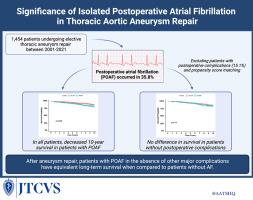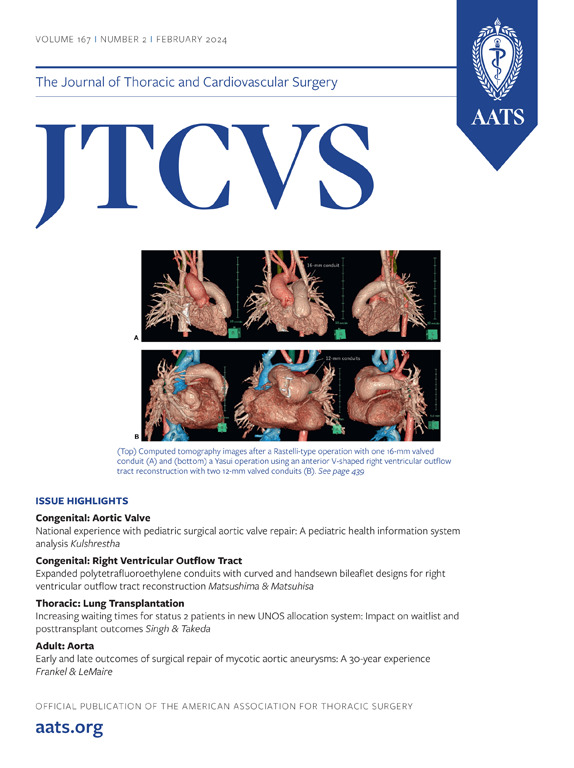胸主动脉瘤修复术后孤立性心房颤动的意义
IF 4.9
1区 医学
Q1 CARDIAC & CARDIOVASCULAR SYSTEMS
Journal of Thoracic and Cardiovascular Surgery
Pub Date : 2025-02-01
DOI:10.1016/j.jtcvs.2023.12.023
引用次数: 0
摘要
方法 这是一项单中心回顾性研究,研究对象为 2005 年 3 月至 2021 年 3 月间接受开胸主动脉瘤修复术的患者。POAF定义为在指数住院期间新发的心房颤动(AF)。不包括术前有房颤的患者。术后主要并发症包括因出血、呼吸衰竭、急性肾功能衰竭和中风而再次手术。通过多变量回归分析了与 POAF 相关的变量。在对基线和术中特征进行倾向评分匹配后,比较了无房颤患者和有 POAF 患者无主要并发症的生存率。POAF 患者的术后主要并发症发生率高于无 AF 患者(20.2% 对 12.2%,P<0.001)。POAF患者的十年生存率为82.0%,无房颤患者为87.0%(P=0.008)。在无并发症的患者队列中,经过倾向评分匹配后,有 POAF 和无 POAF 患者的 10 年生存率相似(83.6% vs. 83.8%,p=0.75)。虽然术后主要并发症的发生与 POAF 和长期生存率下降有关,但孤立的 POAF 似乎并不影响长期生存率。本文章由计算机程序翻译,如有差异,请以英文原文为准。

Significance of isolated postoperative atrial fibrillation in thoracic aortic aneurysm repair
Objective
Although postoperative atrial fibrillation has been shown to be associated with worse survival after thoracic aortic surgery, its effect on outcomes independently from other postoperative complications is not well understood.
Methods
This is a single-center retrospective study of patients who underwent open thoracic aortic aneurysm repair between March 2005 and March 2021. Postoperative atrial fibrillation was defined as new-onset atrial fibrillation that developed during the index hospital stay. Patients with preoperative atrial fibrillation were excluded. Postoperative major complications included reoperation for bleeding, respiratory failure, acute renal failure, and stroke. Variables associated with postoperative atrial fibrillation were analyzed with multivariable regression. Survival of patients without major complications was compared between patients without atrial fibrillation and patients with postoperative atrial fibrillation after propensity score matching for baseline and intraoperative characteristics.
Results
Of 1454 patients, 520 (35.8%) were observed to have postoperative atrial fibrillation. Patients with postoperative atrial fibrillation had a higher rate of postoperative major complications than those without atrial fibrillation (20.2% vs 12.2%, P < .001). Ten-year survival was 82.0% in patients with postoperative atrial fibrillation and 87.0% in patients without atrial fibrillation (P = .008). In the cohort of patients without complications, 10-year survival was similar between patients with and without postoperative atrial fibrillation after propensity score matching (83.6% vs 83.8%, P = .75).
Conclusions
Postoperative atrial fibrillation is common after open proximal thoracic aortic aneurysm repair. Although development of major postoperative complications is associated with postoperative atrial fibrillation and decreased long-term survival, isolated postoperative atrial fibrillation does not appear to influence long-term survival.
求助全文
通过发布文献求助,成功后即可免费获取论文全文。
去求助
来源期刊
CiteScore
11.20
自引率
10.00%
发文量
1079
审稿时长
68 days
期刊介绍:
The Journal of Thoracic and Cardiovascular Surgery presents original, peer-reviewed articles on diseases of the heart, great vessels, lungs and thorax with emphasis on surgical interventions. An official publication of The American Association for Thoracic Surgery and The Western Thoracic Surgical Association, the Journal focuses on techniques and developments in acquired cardiac surgery, congenital cardiac repair, thoracic procedures, heart and lung transplantation, mechanical circulatory support and other procedures.

 求助内容:
求助内容: 应助结果提醒方式:
应助结果提醒方式:


